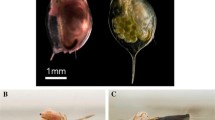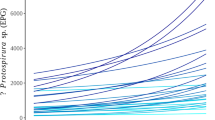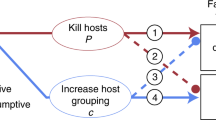Abstract
Preys require effective anti-predator traits to escape from predator attacks, whereas predators focus on individuals that have lower fitness. This fitness reduction is due to the effects of many regulatory forces such as parasites. We directly observed in the field the escape performance of the Iberian hare (Lepus granatensis) against coursing predators (measured as the time to be taken by greyhounds) and examined the relationships between parasite loads and duration of escape behaviours to test the hypothesis that predators would more easily catch substandard individuals. We found a negative relationship between the hare’s escape duration and parasite burdens in various taxa (Taenia pisiformis cisticercus, intestinal Coccidia) as well as with parasite diversity. Moreover, the escape duration of the hares is related positively to their condition. In the particular case of T. pisiformis cisticercus, we found a negative relationship with body condition, suggesting that its effect on anti-predation ability could be mediated by direct spoliation of host resources and/or by increasing requirements for anti-parasite defence. As parasite loads were not directly manipulated, experimental studies are needed to elucidate any causal links between parasite and anti-predatory capacity in Iberian hares.



Similar content being viewed by others
References
Anderson RC (2000) Nematode parasites of vertebrates. Their development and transmission. CABI Publishing, New York
Berdoy M, Webster JP, Macdonald DW (1995) The manipulation of rat behaviour with Toxoplasma gondii. Mammalia 59:605–613
Burnham KP, Anderson DR (1992) Data-base selection of an appropriate biological model: the key to modern data analysis. In: McCullough DR, Barrett RH (eds) Wildlife 2001: populations. Elsevier, New York, pp 16–30
Caro TM, Fitzgibbon CD (1992) Large carnivores and their prey: the quick and the dead. In: Crawley MJ (ed) Natural enemies: the population biology of predators, parasites and diseases. Blackwell, Oxford, pp 117–142
Curio E (1976) The ethology of predation. Springer, Berlin Heidelberg New York
Fitzgibbon CD (1994) The costs and benefits of predation inspection behaviour in Thompson gazelles. Behav Ecol Sociobiol 34:139–148
Fitzgibbon CD, Fanshawe J (1989) The condition and age of Thompson’s gazelles killed by cheetahs and wild dogs. J Zool 218:99–107
Georgi JR, Georgi ME (1990) Parasitology for veterinarian. Saunders, Philadelphia
Gulland FM (1992) The role of nematode parasites in Soay sheep (Ovis aries L.) mortality during a population crash. Parasitology 105:493–503
Holmes JC (1982) Impact of infectious disease agents in the population growth and geographical distribution of animals. In: Anderson RM, May RM (eds) Population biology of infectious diseases. Springer, Berlin Heidelberg New York, pp 37–51
Hudson PJ, Dobson AP, Newborn D (1992) Do parasites make prey vulnerable to predation? Red grouse and parasites. J Anim Ecol 61:681–692
Iason GR, Boag B (1988) Do intestinal helminths affect condition and fecundity of adult mountain hares? J Wildl Dis 24:599–605
Ives AR, Murray DL (1997) Can sublethal parasitism destabilize predator-prey population dynamics? A model of snowshoe hares, predators and parasites. J Anim Ecol 66:265–278
Joly DO, Messier F (2004) The distribution of Echinococcus granulosus in moose: evidence for parasite-induced vulnerability to predation by wolves? Oecologia 140:586–590
Kavaliers M, Colwell DD (1994) Parasite infection attenuates nonopioid mediated predator-induced analgesia in mice. Physiol Behav 55:505–510
Khalil LF, Jones A, Bray RA (1994) Keys to the Cestode parasites of vertebrates. CAB International, Wallingford
Krist AC (2004) Effects of host condition on susceptibility to infection, parasite developmental rate, and parasite transmission in a snail-trematode interaction. J Evol Biol 17:33–40
Lauder GV (1991) An evolutionary perspective on the concept of efficiency: how does function evolve? In: Blake RW (ed) Efficiency and economy in animal physiology. Cambridge University Press, Cambridge, pp 169–184
Libersat F, Moore J (2000) The parasite Moniliformis moniliformis alters the escape response of its cockroach host Periplaneta americana. J Insect Behav 13:103–110
Maule AG, Marks NJ (2006) Parasitic flatworms: molecular biology, biochemistry, immunology and physiology. CAB International, Cambridge
Minchella DJ, Scott ME (1991) Parasitism: a cryptic determinant of animal community structure. Trends Ecol Evol 6:250–254
Møller AP, Erritzöe J (2000) Predation against birds with low immunocompetence. Oecologia 122:500–504
Møller AP, Christe P, Erritzöe J, Mavarez J (1998) Condition, disease and immune defence. Oikos 83:301–306
Moore J (2002) Parasites and the behaviour of animals. Oxford Series in Ecology and Evolution. Oxford University Press (USA)
Moore J, Gotelli NJ (1996) Evolutionary patterns of altered behaviour and susceptibility in parasitized hosts. Evolution 50:807–819
Murray DL (2002) Differential body condition and vulnerability to predation of snowshoe hares. J Anim Ecol 1:614–625
Murray DL, Cary JR, Keith LB (1997) Interactive effects of sublethal nematodes and nutritional status on snowshoe hare vulnerability to predation. J Anim Ecol 66:250–264
Murray DL, Keith LB, Cary JR (1998) Do parasitism and nutritional status interact to affect production in snowshoe hares? Ecology 79:1209–1222
Newey S, Thirdgood SJ, Hudson PJ (2004) Do parasite burdens in spring influence condition and fecundity of female mountain hares Lepus timidus? Wild Biol 10:171–176
Pellerdy L (1974) Coccidia and Coccidiosis. Springer, Berlin Heidelberg New York
Pfennig KS (2001) Evolution of pathogen virulence: the role of variation in host phenotype. Proc R Soc B 268:755–760
Poulin R (1994) Meta-analysis of parasite-induced behavioural changes. Anim Behav 48:137–146
Price PW, Westoby M, Rice B, Atsatt PR, Fritz RS, Thompson JN, Mobley K (1986) Parasite mediation in ecological interactions. Ann Rev Ecol Syst 17:487–505
Rigby MC, Jokela J (2000) Predator avoidance and immune defence: costs and trade-offs in snails. Proc R Soc B 267:171–176
Sáenz de Buruaga M, Lucio AJ, Purroy FJ (1991) Reconocimiento de Sexo y Edad en Especies Cinegéticas. Gobierno Vasco ediciones, Vitoria
Sheldon BC, Verhulst S (1996) Ecological immunology: costly parasite defences and tradeoffs in evolutionary ecology. Trends Ecol Evol 11:317–321
Sokal RR, Rohlf FJ (1979) Biometría. Blume Ediciones, Madrid
Stien A (2002) The impact of gastrointestinal nematodes on wild reindeer: experimental and cross-sectional studies. J Anim Ecol 71:937–945
Temple SA (1987) Do predators always capture substandard individuals disproportionately from prey populations? Ecology 68:669–674
Villafuerte R, Viñuela J, Blanco JC (1997) Extensive predator persecution caused by population crash in game species: the case of red kites and rabbits in Spain. Biol Conserv 84:181–188
Vorísek P, Votýpka J, Zvára K, Svobodova M (1998) Heteroxenous coccidia increase the predation risk of parasited rodents. Parasitology 117:521–524
Watson H, Lee DL, Hudson PJ (1987) The effect of Trichostrongylus tenuis on the cecal mucosa of young, old and antihelmintic treated wild red grouse, Lagopus lagopus scoticus. Parasitology 94:405–411
Webster JP (2006) The effect of Toxoplasma gondii and other parasites on activity levels in wild and hybrid Rattus norvegicus. Parasitology 109:583–589
Wilson K, Grenfell BT (1997) Generalized linear modeling for parasitologists. Parasitol Today 13:33–38
Acknowledgements
We thank to the local hunters from Miguelturra, the Spanish and Castilian Greyhound Federations for logistic support during sampling. We thank F. Salamanca, J. F. Ruiz, E. Chico, M. P. Martín, J. Millán, F. Talavera and E. Lozano for assistance in the sample collection, J. Viñuela for comments on the manuscript and B. Tolhurst, C. Oines, N. Walker and W. van der Loo for English revision, Editor Philipp Heeb and the reviewers made valuable contributions to the manuscript. V. Alzaga enjoyed a grant from Cantabria Government. This study complies with the current laws of Spain. F. Casas enjoyed a fellowship from JCCM.
Author information
Authors and Affiliations
Corresponding author
Additional information
Communicated by P. Heeb
Rights and permissions
About this article
Cite this article
Alzaga, V., Vicente, J., Villanua, D. et al. Body condition and parasite intensity correlates with escape capacity in Iberian hares (Lepus granatensis). Behav Ecol Sociobiol 62, 769–775 (2008). https://doi.org/10.1007/s00265-007-0502-3
Received:
Revised:
Accepted:
Published:
Issue Date:
DOI: https://doi.org/10.1007/s00265-007-0502-3




